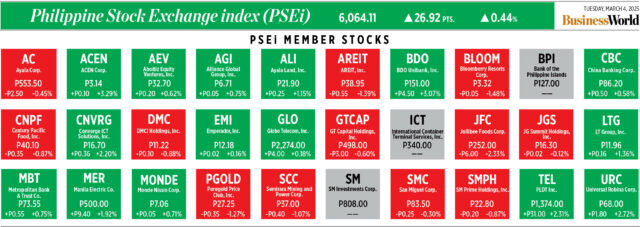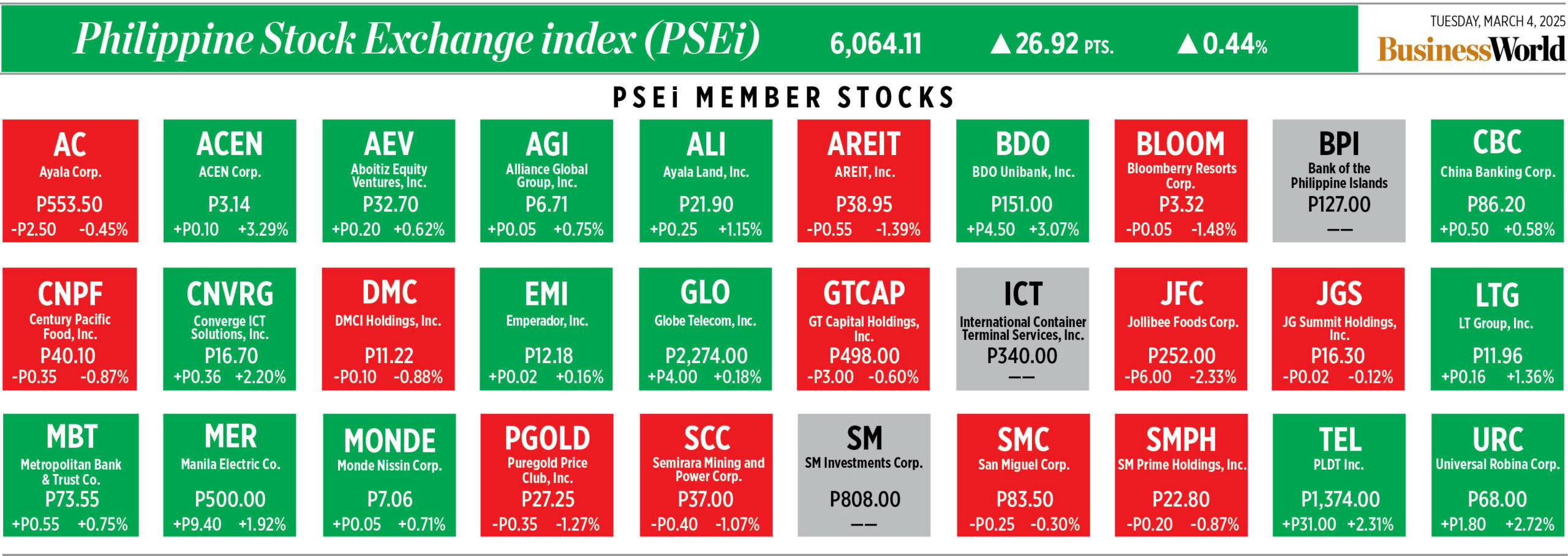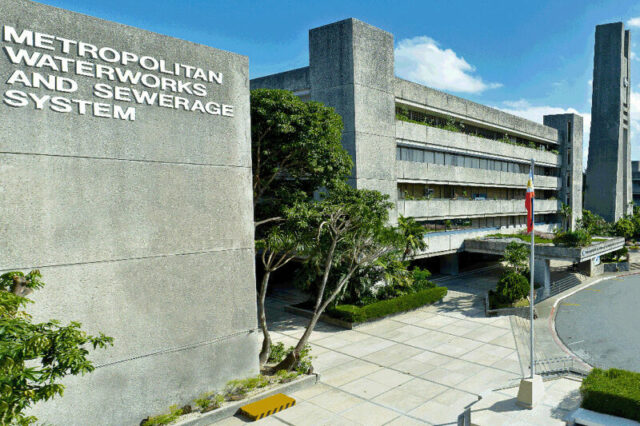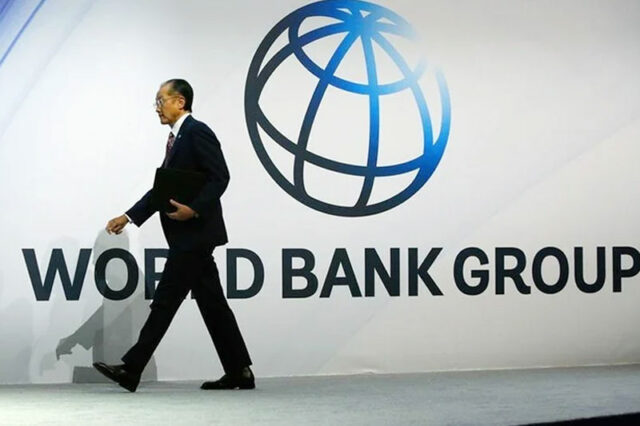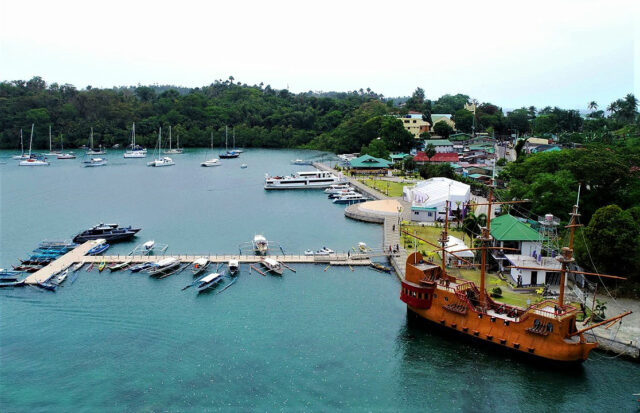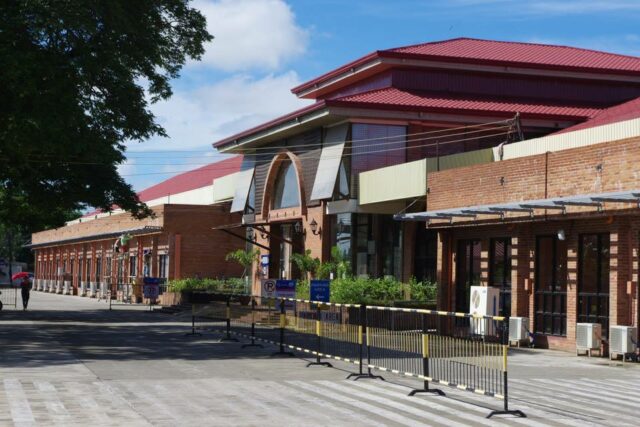PHL stocks climb on earnings, inflation optimism
PHILIPPINE SHARES climbed further on Tuesday as market sentiment was boosted by strong corporate results and optimism that inflation eased in February.
The bellwether Philippine Stock Exchange index rose by 0.44% or 26.92 points to close at 6,064.11, while the broader all shares index increased by 0.24% or 8.84 points to 3,628.96.
“The local market extended its rise, backed by investors’ appreciation of robust corporate results,” Philstocks Financial, Inc. Senior Research Analyst Japhet Louis O. Tantiangco said in a Viber message.
“Optimistic expectations towards the Philippines’ February inflation print also helped in today’s climb,” he added.
Many listed companies have reported strong financial results, with most banks posting record profits in 2024 as the elevated interest rate environment boosted their revenues.
Meanwhile, the Philippine Statistics Authority will release February inflation data on Wednesday (March 5).
A BusinessWorld poll of 18 analysts yielded a median estimate of 2.6% for the February consumer price index (CPI), within the Bangko Sentral ng Pilipinas’ 2.2%-3% forecast for the month. This would be slower than the 2.9% in January. It would also be the lowest print in four months or since the 2.3% posted in October last year.
“The local bourse extended gains as investors seized bargain-hunting opportunities ahead of the CPI release,” Regina Capital Development Corp. Head of Sales Luis A. Limlingan said in a Viber message.
Majority of sectoral indices closed higher on Tuesday. Mining and oil surged by 3.72% or 291.92 points to 8,129.20; financials climbed by 1.27% or 29.02 points to 2,310.48; services increased by 0.72% or 14.02 points to 1,942.52; and industrials went up by 0.49% or 42.15 points to 8,631.33.
Meanwhile, property declined by 0.12% or 2.61 points to 2,167.86 and holding firms went down by 0.07% or 3.61 points to 5,101.61.
“ACEN Corp. led the index members, rising 3.29% to P3.14. Jollibee Foods Corp. was the worst index performer, declining 2.33% to P252.00,” Mr. Tantiangco said.
Value turnover decreased to P7.09 billion on Tuesday with 907.59 million shares traded from the P10.45 billion with 1.62 billion issues exchanged on Monday.
Advancers outnumbered decliners, 107 versus 84, while 49 names were unchanged.
Net foreign selling stood at P266.33 million on Tuesday, a reversal of the P293.79 million in net buying recorded on Monday.
Meanwhile, stocks fell and bond yields slid on Tuesday in Asia with investors ducking for cover as new US tariffs on Canada, Mexico and China took effect, threatening to escalate global trade tensions, Reuters reported.
However, Asian stocks pared initial steep losses, finding some comfort in the measured reaction from US President Donald J. Trump’s tariff targets, although Beijing did immediately announce reciprocal tariffs, as did Ottawa. — R.M.D. Ochave with Reuters
Peso surges to near 3-month high vs dollar
THE PESO surged to a near three-month high on Tuesday as the dollar was weaker due to market worries over the US economy’s health, and before the release of February Philippine inflation data.
The local unit closed at P57.753 per dollar on Tuesday, strengthening by 14.7 centavos from its P57.90 finish on Monday, Bankers Association of the Philippines data showed.
This was the peso’s strongest finish in nearly three months or since its P57.735-per-dollar close on Dec. 6.
The peso opened Tuesday’s session stronger at P57.83 against the dollar. It climbed to as high as P57.75, while its intraday low was at P57.84 versus the greenback.
Dollars exchanged inched down to $1.04 billion on Tuesday from $1.06 billion on Monday.
“The dollar-peso closed lower on worries of a weakening US economy after the ISM (Institute for Supply Management) manufacturing index came in lower and amid rising trade tensions which could also weaken the US economy,” a trader said in a phone interview.
US manufacturing was steady in February, but a measure of prices at the factory gate jumped to nearly a three-year high and it took longer for materials to be delivered, suggesting that tariffs on imports could soon undercut production, Reuters reported.
Worries about duties on imports dominated commentary from manufacturers in the Institute for Supply Management survey on Monday, with most saying the tariffs being pushed by President Donald J. Trump against trading partners such as Canada, Mexico and China had created an uncertain operating environment.
The ISM’s manufacturing purchasing managers’ index (PMI) slipped to 50.3 last month from 50.9 in January, which marked the first expansion since October 2022 and likely reflected factories front-loading imports to beat tariffs. A PMI reading above 50 indicates growth in the manufacturing sector, which accounts for 10.3% of the economy.
Economists polled by Reuters had forecast the PMI would ease to 50.8. Production at factories nearly stalled after rebounding in the prior month. The dip in the PMI mirrored declines in other sentiment measures as the Trump administration pushes ahead with its plan to ratchet up tariffs on imported goods.
Domestic manufacturers rely heavily on imported raw materials. Analysts have warned of financial fallout for US automakers and other companies that manufacture vehicles in Mexico and Canada and sell them in the US. Other duties aimed at imported steel, aluminum and motor vehicles will either soon go into effect or are in fast-tracked development.
Manufacturing only just started recovering after a prolonged downturn triggered by the Federal Reserve’s aggressive monetary policy tightening in 2022 and 2023 to tame inflation. Concerns that tariffs will raise prices contributed to the US central bank’s decision to pause its interest rate cuts in January.
The dollar was weaker against a basket of currencies.
Meanwhile, the peso was also supported by the expected easing in February inflation, Rizal Commercial Banking Corp. Chief Economist Michael L. Ricafort said in a Viber message. The Philippine Statistics Authority will release February consumer price index (CPI) data on March 5 (Wednesday).
A BusinessWorld poll of 18 analysts yielded a median estimate of 2.6% for the February CPI, within the central bank’s 2.2%-3% forecast for the month.
If realized, this would be slower than the 2.9% recorded in January and the 3.4% seen in the same month a year ago. This would also be the slowest in four months or since the 2.3% recorded in October.
For Wednesday, the trader expects the peso to move between P57.60 and P58 per dollar, while Mr. Ricafort sees it ranging from P57.65 and P57.85. — Aaron Michael C. Sy with Reuters
Rice MSRP expected to drop to P45 per kilo
THE Department of Agriculture (DA) said it is expecting a further drop in the maximum suggested retail price (MSRP) of rice due to declining global rice prices and strengthening of the peso.
The government may bring the MSRP to P45 per kilo for imported rice varieties consisting of 5% broken grains in late March from P49, Agriculture Secretary Francisco Tiu Laurel, Jr. told reporters late Monday.
The peso closed at P57.90 to the dollar on Monday, strengthening from its P57.995 on Friday finish.
Mr. Laurel in late February said the DA will apply the MSRP “more selectively” since the prices of imported rice “were already lower than the MSRP” in “some provinces.”
The first MSRP was set at P58 per kilo on Jan. 20.
The retail price for 5% broken rice was P62-P64 per kilo before the MSRP order, which Mr. Laurel said has been effective in influencing market prices.
The government lowered the tariff on rice imports to 15% last year, promising “substantial drops” in rice prices by January.
“From vegetables to rice, prices have declined,” Mr. Laurel said. “Our MSRP is really working.”
The DA declared a national rice emergency, citing an “extraordinary” spike in the prices of the staple grain despite lower tariffs for imports.
A food security emergency declaration — a power given to the DA under Republic Act 12708 or the Agricultural Tariffication Act — triggers the release of rice reserves from National Food Authority warehouses to stabilize prices.
Rice imports hit an all-time high of nearly 4.7 million metric tons in 2024, in the face of inadequate domestic production.
In mid-January, Mr. Laurel said the government does not plan to rely as heavily on imports to bring down high rice prices, which he said are also caused by profiteering. — Kyle Aristophere T. Atienza
MWSS calls dry-season water supply ‘adequate’
THE Metropolitan Waterworks and Sewerage System (MWSS) said the water supply is expected to be adequate for the upcoming dry season.
Compared to last year, water levels at Angat Dam were higher and even above the normal high-water level, according to Patrick James B. Dizon, manager of the MWSS water and sewerage management division.
“This indicates that the water supply will remain adequate throughout the summer and until the end of the year,” he said via Viber on Monday.
On Monday, Angat Dam water was at 213.47 meters, down from the 213.60-meter reading the previous day, according to the government weather service, known as PAGASA.
These readings were higher than the normal high-water level of 212 meters.
“Last year, on this day, (the water level) at the Angat reservoir was 205 meters, and last year, there was no problem with water supply. So based on the elevation today, we are projecting that we will have sufficient water for the duration (of the dry season),” Mr. Dizon said.
Angat Dam is the main source of water for Metro Manila, accounting for about 90% of the capital’s potable water.
The MWSS is tasked with ensuring uninterrupted supply and distribution of potable water and maintenance of sewerage systems in its service area in Metro Manila and parts of Cavite and Rizal.
For March, Mr. Dizon said that Metro Manila has a water allocation of 52 cubic meters per second from the National Water Resources Board.
Water concessionaires in Metro Manila said their plants and alternate water sources are in place.
“The MWSS took proactive steps earlier this year to increase the water level in Angat Dam, ensuring sufficient supply for the summer months,” Jennifer C. Rufo, head of corporate communications of Maynilad Water Services, Inc., said in a Viber message.
Ms. Rufo said that Maynilad has alternate water sources, such as the Laguna de Bay, deep wells, recycled used water, and dams of the National Irrigation Administration in Cavite, to augment supply from Angat.
“Given these preparations, we don’t foresee service interruptions due to water shortages. Any service interruptions that may occur would be due to maintenance activities necessary to sustain service reliability,” she said.
Meanwhile, Manila Water Co., Inc., said it will assist the Bureau of Fire Protection, especially during the dry season, by maintaining 3,294 fire hydrants in the east zone and parts of Rizal as well as four purple hydrants at some of its sewage treatment plants.
The company also has treatment plants and pumping stations to provide additional supply, alongside its aggressive leak detection and repair activities. — Sheldeen Joy Talavera
Banana industry competitiveness eroding as PHL loses position as top supplier to China
By Kyle Aristophere T. Atienza, Reporter
THE displacement of the Philippines by Vietnam as the top banana supplier to China reflects the Philippine banana industry’s declining competitiveness, as well as weak Chinese demand and the impact of plant diseases, analysts and agriculture industry officials said.
Rizal Commercial Banking Corp. Chief Economist Michael L. Ricafort said China’s banana imports last year declined by about 4%, though Vietnam grabbed more market share due to its “lower labor costs and overall cost of living that led to lower prices.”
The International Trade Centre, an arm of the World Trade Organization, reported that China’s banana imports from the Philippines hit a 15-year low in 2024 of 463,306 metric tons. Vietnam’s banana exports to China, meanwhile, rose 24% to 625,166 MT.
Mr. Ricafort cited Vietnam’s proximity to China, which helps cut logistics costs in the face of high fuel prices.
“I think the decline is a result of a combination of the effects of the sigatoka and Panama plant disease and emergence of competing suppliers like Vietnam, which is very competitive and enjoys lower banana tariffs,” Federation of Free Farmers National Director Raul Q. Montemayor said via Viber.
Philippine banana exports overall fell 2.97% to 2.28 MT in 2024, ceding its position as the third-leading banana exporter.
The Food and Agriculture Organization (FAO) at that time noted that Philippine supplies continued to be affected by “the spread of TR4,” a variety of Panama disease or fusarium wilt.
The Tropical Race 4 strain, a soil-borne fungal disease that deprives bananas of minerals, nutrients, and moisture, was first detected in Davao City in 2009 and still threatens the Cavendish banana, the main export variety.
“Geopolitics and competitiveness has a lot to do with Philippines losing its market share,” according to Philippine Chamber of Commerce and Industry Chairman George T. Barcelon, former chairman of the Philippine Exporters Confederation, Inc. He did not elaborate.
Mr. Ricafort said geopolitical risks are also playing a part due to ongoing tensions between the Philippines and China in the South China Sea, which Beijing claims almost in its entirety.
“The dispute partly led to lower demand for Philippine exports such as bananas,” he said.
China is the Philippines’ largest source of imports and the second-biggest market for exports. Two-way trade hit $41 billion in 2023.
Mr. Ricafort cited the flare-up of tensions in 2012, when China imposed what industry representatives called “unbelievably” tight quarantine rules for Philippine fruit products, with Beijing allegedly detecting mealy bugs in Philippines fruit.
“Whenever there were tensions in the past, China would resort to phytosanitary requirements to prevent some Philippine fruit exports to China, causing Philippine products to rot in ports,” he said.
The quarantine restrictions followed a standoff at Scarborough Shoal, although government officials said at the time that phytosanitary issues had surfaced even before the conflict.
“Panama disease is more manageable than the loss of warmer bilateral relations between the Philippines and China, which is driven by the geopolitical dynamics brought about by the Taiwan issue that pits the US and its allies against China,” according to retired agriculture professor Roy S. Kempis, who heads the Center for Business Innovation at Angeles University Foundation.
“The Philippines is directly on the receiving end as well as a victim of collateral damage,” he said via Viber. “While we have the best tasting bananas in the world, the reality is, this can be ignored by China for geopolitical vengeance and gain.”
Mr. Kempis said moving forward, the logical step is to find alternative markets for Philippine bananas.
Mr. Ricafort said another key market for Philippine bananas is South Korea, with which Manila recently signed a free trade agreement.
The deal allows the Philippines to export fresh bananas to South Korea at zero duty by January 2028, “with tariffs starting at 24% upon entry, falling to 18% by January 2025,” according to the Department of Trade and Industry.
Philippine banana market share in South Korea fell 11 percentage points between January and August 2024.
The FAO said in January that Philippine exports to China and Japan declined last year due to a shortfall in domestic supply, noting that only 51,000 hectares out of the 89,000 hectares of land available for banana cultivation were operational.
$1-B World Bank loan deal due for signing in July
THE PHILIPPINES is set to sign in July a $1-billion loan agreement with the World Bank to support its sustainable agriculture transformation program.
The Department of Agriculture (DA) issued the statement after a meeting between Secretary Francisco P. Tiu Laurel, Jr. and World Bank Country Director Zafer Mustafaoglu on Feb. 10.
The signing of the $1-billion Philippine Sustainable Agricultural Transformation (PSAT) loan program set for July “coincides with President Ferdinand Marcos, Jr.’s fourth State of the Nation Address,” the DA said in a statement.
The five-year PSAT initiative, scheduled for launch in August, seeks to strengthen the agri-fishery sector by providing targeted support to agri-food systems, including climate-responsive strategies, policy reforms, and enhanced fiscal management.
“As the Philippines’ first project under the World Bank’s Program-for-Results (PforR) financing framework, PSAT aims to improve the efficiency of government spending while ensuring sustainable outcomes by building institutional capacity and strengthening governance,” the DA said.
Mr. Laurel and Mr. Mustafaoglu also discussed a $15-million grant funded by the UK for technical assistance that will help the DA implement the transformation program by “enhancing internal audits, evaluating resource use alternatives, assessing sectoral transformation, and expanding the availability of improved planting materials for high-value crops.”
“This supplementary funding, processed through the Philippine government system, will be endorsed by the Department of Finance and the National Economic and Development Authority through the Development Budget Coordination Committee,” the DA said. — Kyle Aristophere T. Atienza
P704.55-M Puerto Galera cruise terminal deal awarded to Ormoc-based contractor
THE Philippine Ports Authority (PPA) said a construction company based in Ormoc City won the P704.55-million contract to build a new cruise terminal in Puerto Galera.
In a notice of award dated Feb. 26, the PPA awarded the contract to Premium Megastructures, Inc., which was the low bidder, according to the PPA bids and awards committee.
The PPA said 11 companies bought bid documents for the cruise ship project but only 10 submitted bids. The other bidders were MAC Builders Corp.; Khan Kon Chi Construction and Development Corp.; WTG Construction and Development Corp.; Sunwest, Inc.; SB Construction Corp.; Goldridge Construction and Development Corp.; Luzviminda Engineering; Bemkar Construction and Supply; and UKC Builders, Inc.
The port regulator issued the bid invitation for the project in December. In its bid notice, the PPA said the winning contractor is required to build the project at the Poblacion site in Puerto Galera within 780 days.
The PPA’s website lists the Ports of Currimao in Ilocos Norte, Salomague in Ilocos Sur, as well as facilities in Manila, Bohol, and El Nido, Palawan as currently equipped to accommodate cruise vessels. — Ashley Erika O. Jose
Safeguard duty probe into cement imports launched
THE Tariff Commission (TC) said on Tuesday that it launched formal proceedings to determine whether to impose safeguard duties on imports of ordinary Portland cement and blended cement from various countries.
“(This follows the) receipt of the request from the Secretary of Trade and Industry and the complete case records,” the TC said in a notice.
“Relative thereto, a preliminary conference is hereby scheduled on March 13 at 10 a.m.,” it added.
Last month, the Department of Trade and Industry (DTI) issued an order imposing provisional safeguard duties of P400 per metric ton or P16 per 40-kilogram bag in the form of a cash bond on imports of ordinary Portland cement and blended cement.
According to Department Administrative Order No. 25-01, the provisional duties apply to those classified under AHTN Code Nos. 2523.29.90 and 2523.90.00.
They will be in force for 200 days from the date of issuance by the Bureau of Customs of a Customs Memorandum Order or Circular.
“This decision is based on the affirmative findings after conducting the preliminary safeguard measures investigation and considering the submissions of interested parties and pieces of evidence made available to the department,” the DTI said.
Citing findings from the period of investigation (PoI) between 2019 and to 2024, the DTI said that the market share of domestic cement producers decreased from almost 78% in 2019 to almost 68% in 2023.
Imports are estimated to have displaced Philippine-made cement, taking the 22% market share of imports in 2019 to 32% in 2023.
It resulted in the domestic industry’s declining sales, production, capacity utilization, profitability, and employment, the DTI said.
“The condition of the domestic industry worsened in 2023 when imports recorded their highest market share at 32% while the domestic industry shrank to the lowest level of sales,” it said.
“In addition, the domestic industry’s lowering of prices even with the rising cost of production to compete with the imports has impacted the domestic industry’s profitability, recording its first operating loss in the PoI,” it added.
Currently, the Philippines imposes an anti-dumping duty against cement imports from Vietnam, which accounted for 94% of cement imports in 2024. — Justine Irish D. Tabile
SteelAsia switches on Bulacan solar rooftop in decarbonization push
STEELASIA Manufacturing Corp. said it commissioned its first solar rooftop photovoltaic (PV) system at its Meycauayan steel plant in Bulacan.
“This solar project is a crucial step in reducing the company’s environmental impact while ensuring energy sufficiency across our operations,” the company said in a statement on Tuesday.
The 1.9-megawatt-peak solar rooftop PV system was installed in partnership with TotalEnergies ENEOS.
“With over 3,200 solar modules installed, the system will generate approximately 2,700 megawatt-hours of renewable electricity annually,” SteelAsia said.
The company is seeking to decarbonize its steel manufacturing operations.
“Two other plants — the Calaca green steel manufacturing plant and the Compostela, Cebu rolling mill — are already powered by geothermal energy,” it added.
SteelAsia currently operates four steel mills that have a total capacity of 2.5 million metric tons per year. These are Meycauayan Works, Calaca Works, Davao Works, and Compostela Works.
It is also constructing a green steel H beam plant in Lemery, Batangas, and will begin site development in Candelaria, Quezon for a second green steel H beam plant worth P30 billion. — Justine Irish D. Tabile
Exporters warned of tougher EU packaging rules
EXPORTERS will have 18 months to comply with the European Union’s (EU) new packaging and came into force on Feb. 11, the Department of Trade and Industry (DTI) said.
“Philippine exporters to the EU are strongly advised to ensure that their packaging materials are recyclable, reusable, and have the necessary proportion of recycled content in order to comply with the new EU PPWR,” the DTI said in an advisory on Monday.
“Exploring sustainable packaging options and comprehending compliance expectations may be substantially aided by careful coordination and collaboration with EU importers. Maintaining records to demonstrate compliance is recommended,” it added.
The DTI said that the new regulation will replace Directive 94/62/EC on packaging and packaging waste and aligns with the EU’s Circular Economy Action Plan.
“The PPWR will be applicable from Aug. 12, 2026, allowing stakeholders an 18-month transition period to adhere to the new regulations. The full implementation will be rolled out over the next 15 years,” the DTI said.
The new regulation harmonizes the packaging laws of EU member states to mitigate the adverse effects of packaging on human health and the environment.
“The primary objective of the regulation is to prevent and reduce packaging waste by promoting more reuse and refill systems. It seeks to make all packaging on the EU market recyclable in an economically viable way by 2030,” the DTI said.
“Additionally, the regulation aims to safely increase the use of recycled plastics in packaging, phase out hazardous and harmful substances such as per- and polyfluoroalkyl substances (PFAS), promote re-use, and decrease the use of virgin materials, ultimately putting the sector on track to achieve climate neutrality by 2050,” it added.
After its full application on Aug. 12, 2026, the European Commission is set to establish specific criteria and methods related to packaging on Jan. 1, 2028.
By Jan. 1, 2040, all packaging sold in the EU must be recyclable, with minimum content requirements for plastics. According to the DTI, packaging with recyclability of lower than 70% will be restricted.
On the same date, reusable packaging should only be used for transport packaging between sites of the same business or between different businesses within the same EU country.
For transport packaging for e-commerce, at least 40% should be reusable by 2030, and at least 70% by 2040, while grouped packaging must be at least 10% reusable by 2030 and 25% by 2040.
For alcoholic drinks and drinks excluding milk, wine, and some spirits, packaging should be at least 10% recyclable by 2030 and at least 40% by 2040. Cardboard packaging is excluded from all reuse targets.
By Jan. 1, 2035, packaging must be recyclable at a scale, while by Jan. 1, 2028, packaging may only enter the market if it has recyclability grades of A or B.
By 2040, the EU plans to further increase recycled content requirements for plastic packaging. — Justine Irish D. Tabile
PPP Center, Ilocos Norte sign infra promotion deal
THE Public-Private Partnership (PPP) Center and Ilocos Norte province signed an agreement to boost the province’s infrastructure and support its agriculture and technology industries.
In a statement on Tuesday, the National Economic and Development Authority (NEDA) said the memorandum of agreement (MoA) aims to boost infrastructure development.
“By leveraging the strengths of both the public and private sectors, we can mobilize resources, enhance efficiency, and ensure long-term sustainability in our development efforts,” NEDA Secretary Arsenio M. Balisacan said.
The signing took place at the PPP Center office in Quezon City on Feb. 28.
NEDA said the MoA seeks to highlight the pipeline of PPP projects and support various stages of the PPP implementation process.
“I hope the activities outlined in the MoA and the lineup of proposed projects by the Provincial Government inspire other local government units and implementing agencies to explore PPPs as a means for rapid and sustainable economic transformation,” Mr. Balisacan said.
Under the agreement, the NEDA said plans include “reviving international flights to destinations such as China, Hong Kong, and Taiwan at Laoag International Airport” to boost the province’s tourism, economy, and improve linkages to international markets.
Governor Matthew J. Marcos Manotoc is hoping to attract airlines to Laoag International Airport for direct services to destinations like Honolulu.
“The partnership also includes policies to support the agriculture sector by empowering farmers through the organization of cooperatives to promote sustainable agricultural practices,” NEDA said.
Innovations in renewable energy, data centers, and manufacturing are also contemplated in the agreement. — Aubrey Rose A. Inosante

